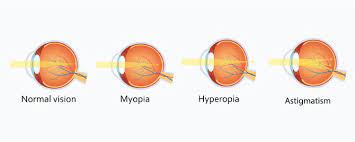New Year, New Vision!
Are you ready for 2021? Will you make the standard list of resolutions – all with the best of intentions to put yourself first? It’s tempting to...
3 min read
 The Rochester Eye & Laser Team
:
Oct 17, 2022 12:29:19 PM
The Rochester Eye & Laser Team
:
Oct 17, 2022 12:29:19 PM

 Are you looking for options when it comes to vision correction? Living with glasses and contact lenses doesn’t have to be the only way.
Are you looking for options when it comes to vision correction? Living with glasses and contact lenses doesn’t have to be the only way.
For many people, LASIK is one of the most popular elective vision correction procedures available, and for a good reason. With a patient satisfaction rate of over 96%, it’s easy to see why people choose LASIK over and over again.
Those who choose LASIK can achieve visual freedom by correcting refractive errors like nearsightedness, farsightedness, and astigmatism. Yes, even if you have astigmatism, you may still be able to get LASIK.
Keep reading to learn more about LASIK and why you may still be able to have the procedure with astigmatism!

Refractive errors are caused by how light refracts when it passes through your cornea. Your cornea is the clear, front part of your eye.
Light passes through the cornea and allows you to see. When light passes through the cornea, it bends or refracts. When it refracts, it refers to how light changes directions before it hits the back of your eye.
The retina, which lines the back of your eye, receives the light and translates it into impulses sent to your brain. Your brain then perceives the impulses as images.
When your cornea isn’t as round as it should be, light doesn’t refract through it correctly, causing a refractive error. Nearsightedness and farsightedness develop when the cornea is too steeply curved or not curved enough.
With astigmatism, it’s a bit different. Astigmatism occurs if your cornea is closer to a football shape instead of round like a sphere.
Nearsightedness and farsightedness only cause blurry vision if an object is too far away or too close. But with astigmatism, you’ll have blurry vision at all distances.
People with nearsightedness and farsightedness often also have some degree of astigmatism. Luckily, LASIK can correct any combination of refractive errors within certain limits.
It can correct up to -12.00 diopters of nearsightedness, +6.00 D of farsightedness, and 6.00 D of astigmatism. This range includes most people with refractive errors, even those with a high degree of astigmatism.
If your astigmatism prescription is higher than the treatment range of LASIK, you may be a good candidate for another procedure like PRK.
 Now that you understand how astigmatism affects your vision, it’s time to discuss how LASIK can correct your vision. How exactly can LASIK correct refractive errors?
Now that you understand how astigmatism affects your vision, it’s time to discuss how LASIK can correct your vision. How exactly can LASIK correct refractive errors?
LASIK works because it involves reshaping your cornea. LASIK uses two lasers: a femtosecond and an excimer laser.
A femtosecond laser first creates a flap in the cornea during the procedure. This tiny flap is made right on the top of the cornea, and the femtosecond laser creates it by separating all but a hinge of corneal tissue.
The second laser is an excimer laser which reshapes tissue in the cornea. The excimer laser reshapes tissue in the cornea’s middle layer located under the flap. This process uses corneal mapping to determine the exact amount of tissue to remove.
Afterward, the flap is replaced and acts as a natural bandage that protects your eye as it heals. The reshaping of the tissue “inside” the cornea makes LASIK more advanced than previous refractive laser eye procedures.
While it may sound a little complex, LASIK is a straightforward procedure that only takes a few minutes per eye to complete. You also won’t feel any pain because you’ll receive numbing eye drops before the vision correction procedure begins.
Ultimately, you’ll be left with incredible vision that you can enjoy for decades to come!
Patient Testimonial: "I don't have to think about it. I can wake up and see! It's life changing. I wish I made that decision much sooner."
Most people with a refractive error within the acceptable treatment limits make great LASIK candidates. But there are a few other requirements before you qualify for the procedure.
You must be 21 or over, in good health, have a stable prescription, and have no other eye conditions besides a refractive error. You also need to have corneas that are thick enough to create a flap during the procedure safely.
When you get evaluated for LASIK at the Rochester Eye and Laser LASIK Center, we will assess how healthy your eyes are and the thickness of your corneas. Knowing this information will help ensure that the vision correction procedure is safe for you to undergo.
LASIK is the best option for vision correction surgery if you have more severe astigmatism or know you’re farsighted.

Whether or not you have astigmatism, there’s an excellent chance LASIK can help you achieve the vision of your dreams. Most patients end up with crisper, clearer vision than they could ever achieve when they had to wear glasses or contact lenses.
Most patients end up with 20/20 vision or better. That includes patients who have astigmatism.
The recovery process is also relatively easy as the corneal flap aids healing by acting as a natural bandage. Between the quick procedure and recovery time, it’s no wonder LASIK is so popular.
If you have a refractive error and want to live your life unburdened by glasses and contact lenses, contact Rochester Eye and Laser Center today to schedule your free consultation. We can help you determine if LASIK or another one of our vision correction procedures is right for you!
Isn’t it time to see the world as it was meant to be seen?
Want all your questions about LASIK answered? Join us this Thursday at 5:30PM. Click below for more information. Save $600 on LASIK.

Are you ready for 2021? Will you make the standard list of resolutions – all with the best of intentions to put yourself first? It’s tempting to...

Much like screen time, video games can be played as a way to wind down after a long day or hype yourself up after winning and advancing to the...

1 min read
LASIK eye surgery is a quick and simple procedure that typically results in patients having 20/20 vision immediately following...